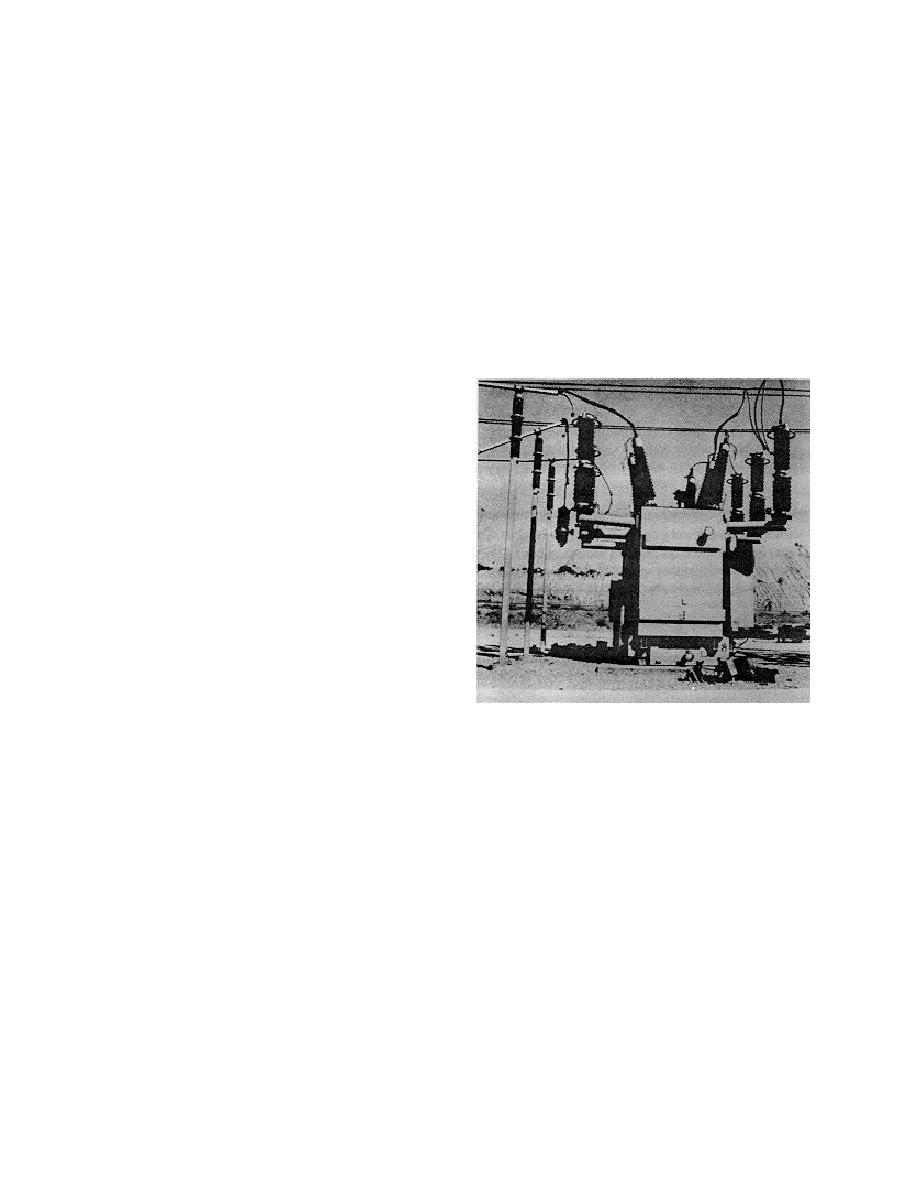
ETL 1110-2-533
30 Sep 94
derived from the output of some of the main turbines
ground motions require that transformer anchorage
or off the input bus to the step-up transformers. At
must be able to withstand the large loads associated
some dams an external line from a distribution sub-
with transformers, which frequently weigh in excess
station of the local utility will provide power. Thus,
of 500,000 lb.
if the step-up transformers trip off-line due to sudden
pressure relays and the main turbines, which are
(c) An unanchored transformer (Figure B-19)
connected to house transformers, happen to be shut
can slide on its supporting pad as the pad vibrates
off, the plant will go dark. Systems with battery or
back and forth in an earthquake. This is a means of
engine generator back-up power should remain
base isolation. One of the advantages of this
operational.
"anchorage" approach is that the transformer experi-
ences lower horizontal accelerations than it would had
it been fixed to its support pad. This would reduce
b. Power switchyard equipment including
inertial forces on bushings, radiators, and internal
step-up transformers. A broad range of high voltage
components.
(220 kV and above) switchyard and substation equip-
ment has been demonstrated to be seismically vulner-
able. The equipment that is an integral part of dam
facilities are step-up transformers, lighting and surge
arrestors, circuit breakers, disconnect switches, wave
traps, and bus support structures and bus. The seis-
mic performance of switchyard equipment is closely
correlated with its operating voltage. Equipment with
operating voltages below 220 kV, if it is adequately
anchored, has performed well. Equipment with oper-
ating voltages of 220 kV and above has experienced a
broad range of failures, most of which are associated
with inadequate anchorage or the failure of porcelain
members which are part of the equipment. Porcelain
members are more vulnerable the higher their operat-
ing voltage.
(1) Power transformers.
(a) Transformers perform a vital function for
which there is no substitute. Without the step-up
Figure B-19. Unanchored transformer. Sliding of
transformers, power generated in the dam cannot be
an unanchored transformer caused one surge
supplied to the power grid. Several types of earth-
arrestor to fail. Several bus connections to bush-
quake damage or earthquake-induced responses have
ings and surge arrestors also failed. The failure of
been observed: damaged surge arrestors associated
the bus connections probably prevented surge
with transformers, leaking bushings, radiator leaks,
arrestor and bushing damage
cracked bushings, damaged control cables, vibration-
activated sudden pressure relays, spurious operation
(d) There are several reasons why this approach
of mercuroid switches, failed anchorage, failed surge
is not recommended. There is no way to predict the
tank support, internal failure, and damage to tertiary
motion of the transformer relative to its support pad.
bushings and surge arrestors.
A transformer with permanent movement of almost
3 ft has been observed in a moderate earthquake. If
(b) Inadequate transformer anchorage is one of
there is slight differential settlement of the foundation
the main causes for failure. Four general approaches
pad, very large motions may occur when the trans-
are used to support and restrain power transformers.
former slips off of its sloping pad. Large motions
Transformers can be unanchored on a concrete pad,
can damage bus connections or the porcelain mem-
rail-mounted, bolted to a concrete pad, or welded to
bers to which the bus is connected.
steel embedded in a concrete pad. Within each type
there are many variations. Earthquake-imposed
B-14



 Previous Page
Previous Page
